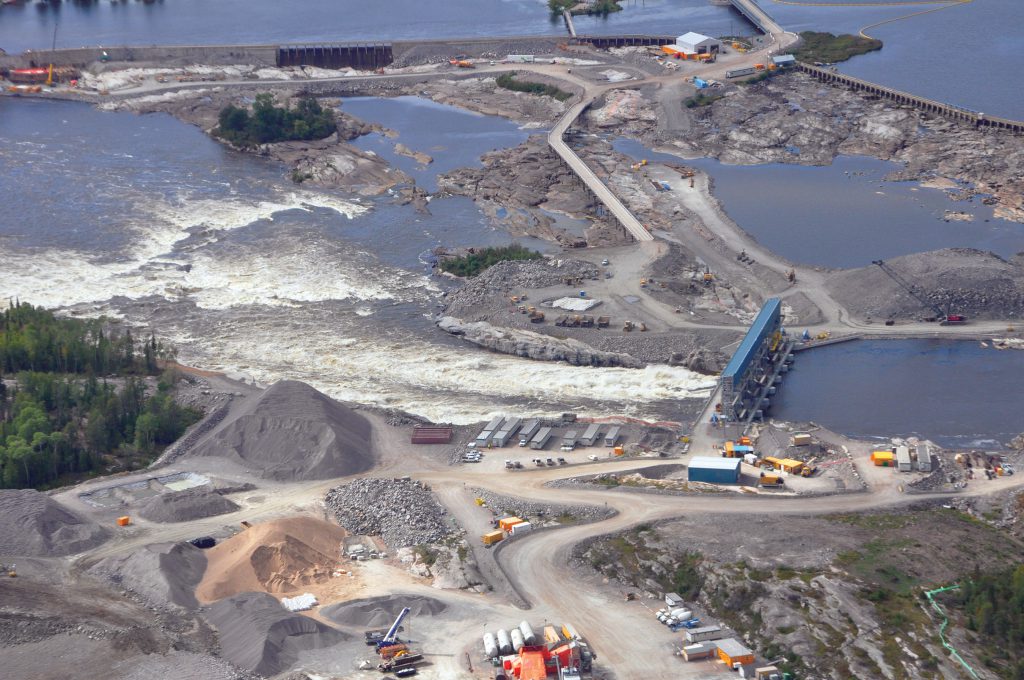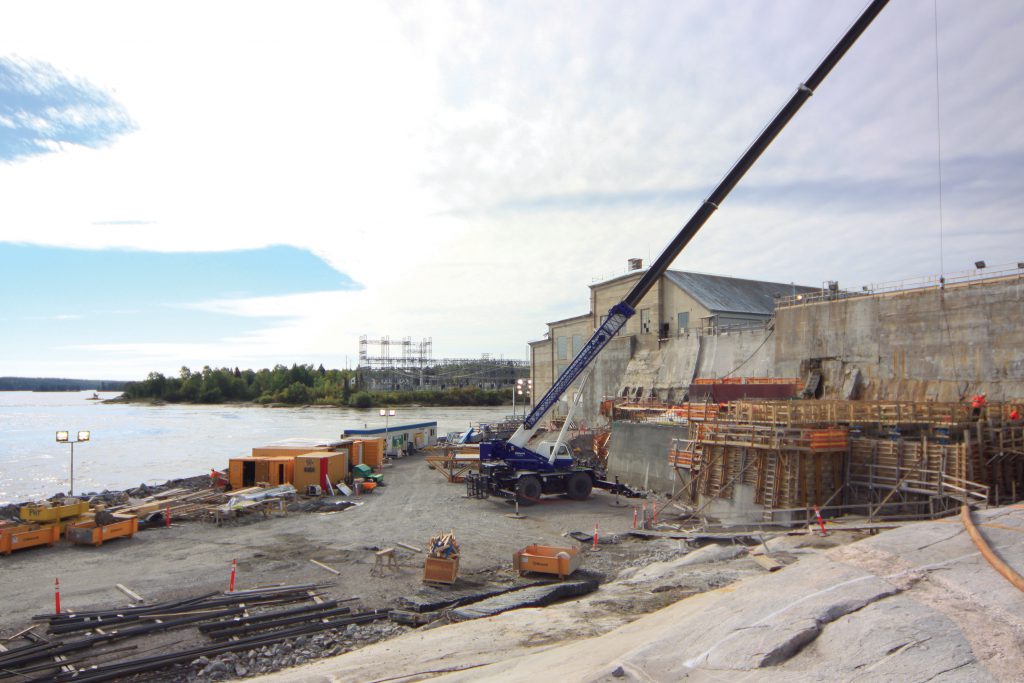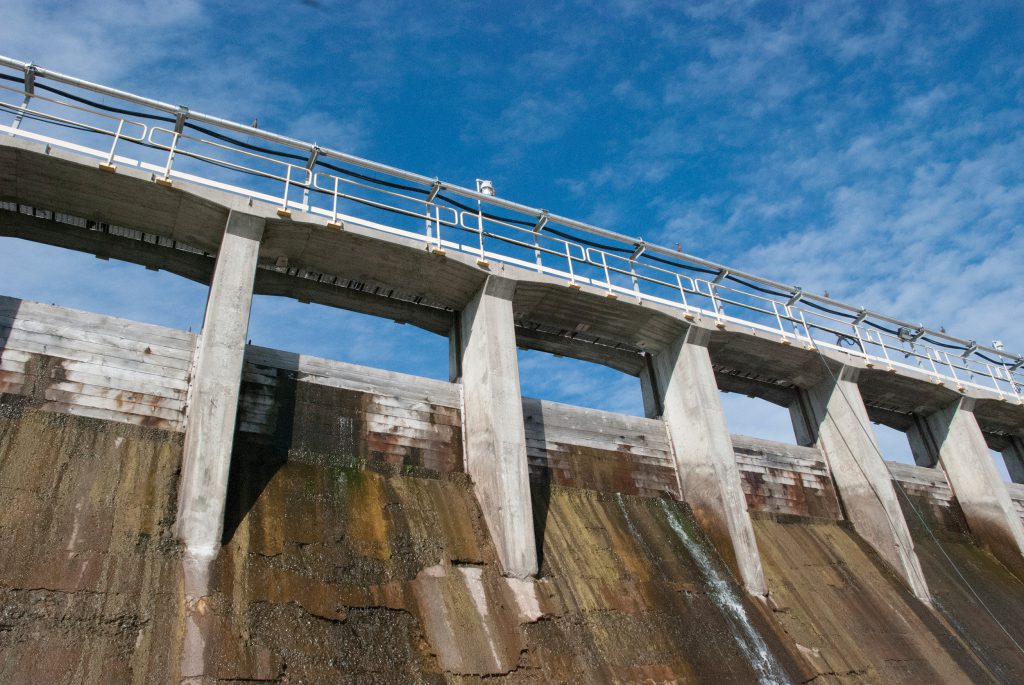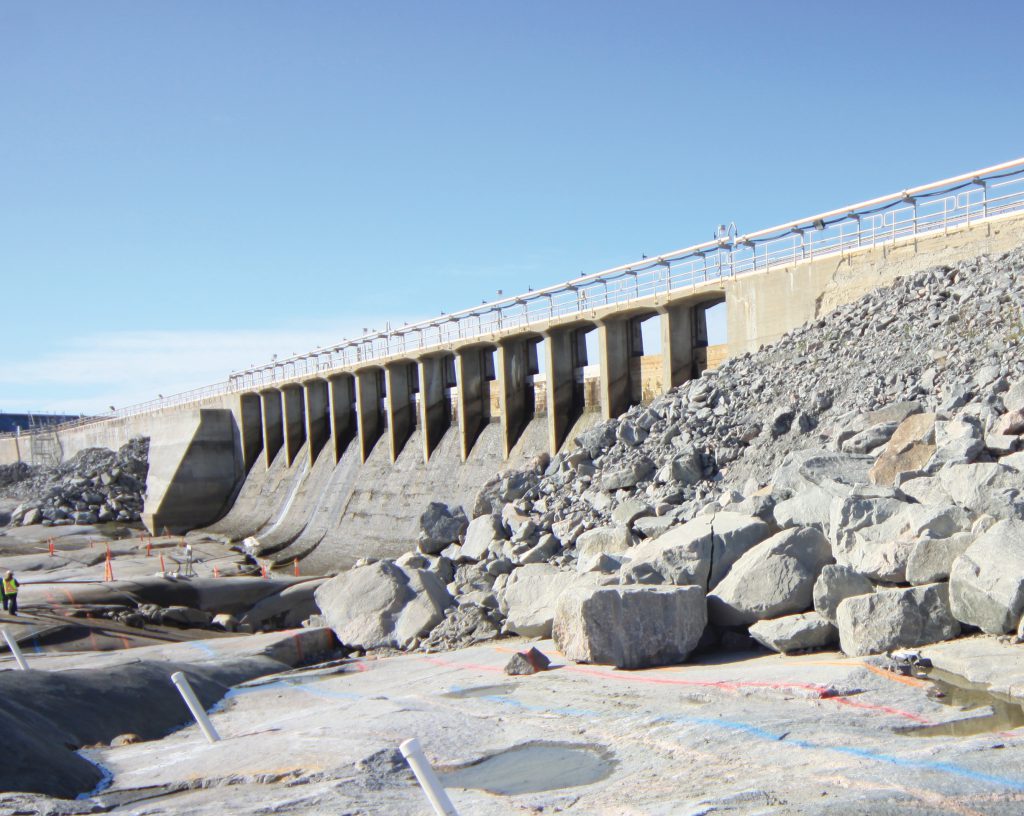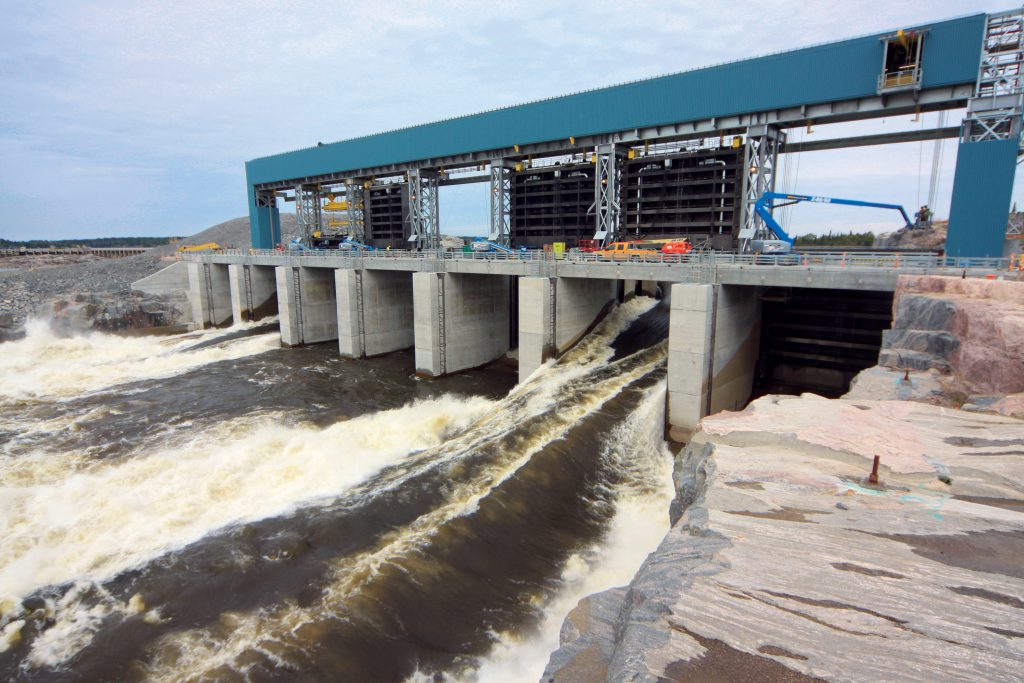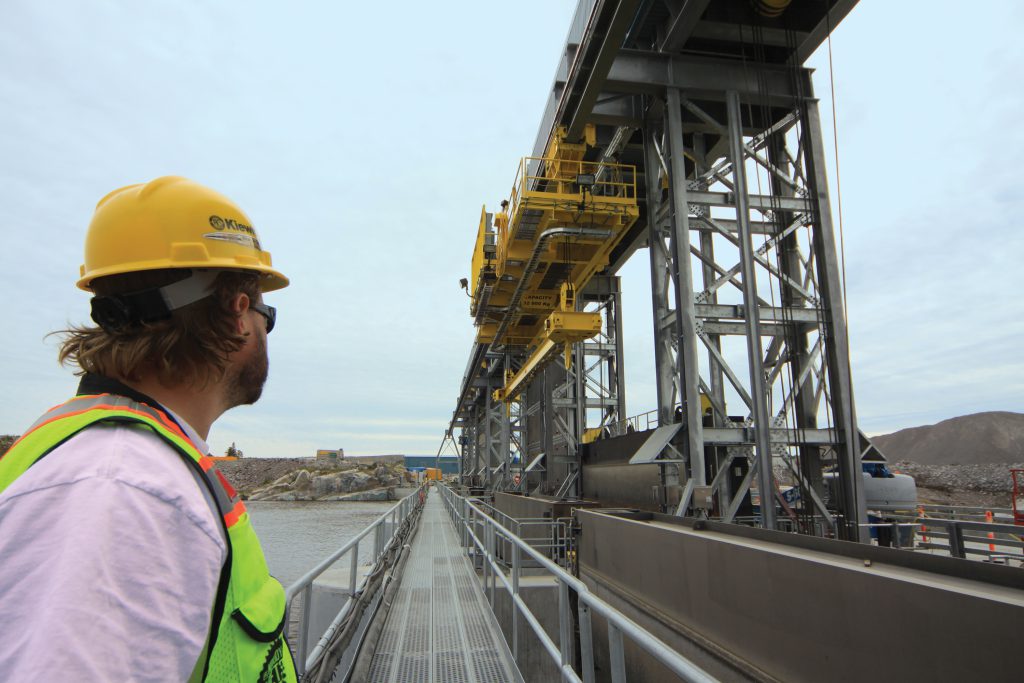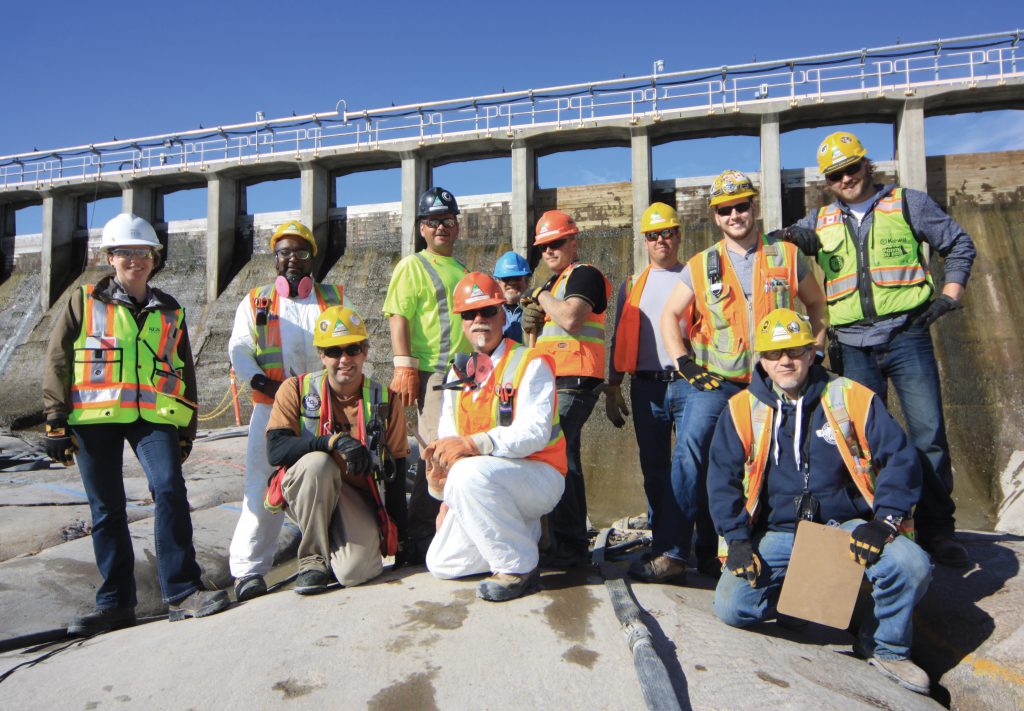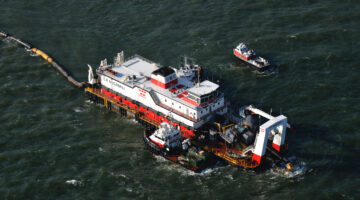For more than a century, a single powerhouse and 97 spill gates have regulated water flow on the Winnipeg River in Pointe du Bois, Manitoba, Canada. The structures were built with the best resources available in the early 20th century, but since then technology has changed dramatically.
In 2012, Manitoba Hydro, which operates and maintains the Pointe du Bois generating station and spillway, approached Kiewit for an Early Contractor Involvement (ECI) contract to provide engineering, earthworks, concrete, mechanical and electrical services to bring the antiquated system up to date.
KGS, the project’s designers, were crucial in helping Kiewit come up with solutions to challenges and worked closely with Kiewit and Manitoba Hydro during every step of the process.
Manitoba Hydro realized a major flood could impact the existing structures, including the dam and powerhouse.
Before Kiewit arrived on site, the spill gates — which regulate the river’s flow — were wooden timbers stacked one on top of the other, hundreds of feet up from the river bottom. To change the water elevation, workers originally lifted the timbers with old-fashioned hand cranks, and more recently, with an electrical winch system. If a flood was imminent, this was a dangerous and high-pressure task for all involved.
The timing of the project would turn out to be especially memorable. Eighteen months after construction began, the entire province faced massive flooding. In July 2014, the residents of Pointe du Bois found themselves preparing for a 100-year flood.
“Ontario, Manitoba’s neighboring province, released a lot of water from its rivers, which pushed huge amounts into the Winnipeg River,” explained Kiewit commercial manager Ameer Balouch. “We had to perform an emergency response to the flood at the request of our client. We ended up releasing water through one of the gates that was actually under construction.”
Establishing the best design
Instead of refurbishing the dam and spillway as originally planned, the client decided to build a new dam and new spillway to the east. The new structures would meet current Canadian Dam Association guidelines.
“Manitoba Hydro had the foresight to expect the worst,” said Balouch, “and Kiewit experienced the worst last summer. Since we had the appropriate procedures in place, we were fortunate and able to handle this massive river flow.”
A portion of the Winnipeg River is diverted into the old powerhouse, but control of the water’s elevation takes place through the new spill gates.
“The experience KGS had with this kind of work was a great asset — they were able to stay on top of the changes and work closely with both Kiewit and Manitoba Hydro to make this project a reality,” said Balouch.
“The final design we agreed on was seven mechanically-operated gates that raise and lower to control the elevation upstream,” explained Balouch. “This mechanism will prevent flooding of the powerhouse and maintain the water at a certain elevation.”
Through innovation and technological advances, those seven gates replaced the original 97.
“Instead of having manual laborers use hand cranks to lift and lower wooden beams, one person can sit at a computer and change the steel gate heights with the push of a button,” Balouch added.
Getting to that point
The 97 gates still served a purpose — they were sealed to act as a temporary dam. To control the flow of water, divers swam to the bottom of the river and, using cinders and oakum (a mossy material), filled and sealed between the current timbers, preventing water flow.
Once the water was removed from the old riverbed, crews began a process called curtain wall grouting. They drilled into the existing rock and pressure-grouted underneath to seal any cracks under the rock to protect the new dam. During curtain wall grouting, separate crews began placing concrete in the deep voids to obtain a better seal for the future impervious (clay) fill of the dam structure.
“After the curtain wall grouting and foundation preparation are complete, we will build the new clay-core dam about 500 feet downstream of the current dam,” said Balouch. “We’ve built a tie-in wall with the existing powerhouse structure and spillway. We’ll decommission the existing spillway by removing the old timber gates and allowing the water to fill in.”
Construction of the new spillway has also required a new channel.
“We blasted and excavated a channel from the dam to the spillway,” he said. “We left a 90- by 50-foot section in place that we called the ‘rock plug.’ This plug kept the other side of the channel dry while we built the spillway and all of the piers.”
Mechanical and electrical work on the gates followed. Once the stop logs were in place, Kiewit flooded the channel upstream and installed a “bubble curtain” to reduce the vibration from the blast on the newly installed gates. The crews subsequently blasted and excavated the rock plug.
Additional work
For now, there are no plans to rebuild the 100-year-old powerhouse, so the team is doing rehab on the east and west sides of the building.
“We had divers video the old structure to assess the damage. From our findings, we anticipate demoing one to two feet of the existing surface of the structure and pouring back the walls because they have started to erode,” Balouch explained.
“We have five custom-made cofferdams that were designed by Kiewit’s Engineering team to help with rehabbing 20 sections of the old dam.”
Crews submerged the dams into the water and sealed them up against the existing structure; they will demolish the existing concrete that has started eroding and pour back with new concrete. After curing, the cofferdams are jumped to the next section, meaning the cofferdam will be pulled out and moved to the next section. This occurred for all 20 sections on the old dam wall.
As cold as Mars
Not only has Kiewit taken on a fairly unique project — and bounced back from the 100-year flood during spillway construction — but, the project team has also faced some cruel weather conditions.
“Winter 2013 was one of the worst Manitoba has experienced since the 1950s,” said Balouch. “Temperatures reached lows to where Fahrenheit and Celsius were nearly the same. For a while we sat at minus 45 degrees Fahrenheit and Celsius. With the wind chill, our temperatures got as low as minus 55 degrees Celsius [minus 67 Fahrenheit]. It was literally as cold as Mars here in Pointe du Bois.”
To meet schedule milestones, some crews had to work in that weather — in heated structures, of course.
“We’re already five months into our winter and have about one more month left,” he added. “We’re all looking forward to the warmer temperatures.”
For this year, the client and Kiewit opted to put a scheduled shutdown in place from mid-December to the end of March.
“Some operations for dam replacement simply cannot happen during our winter. We’ll be bringing the crews back in at full-steam at the beginning of April.”
Safety and engagement
“For 2014, we didn’t have a single recordable incident,” said Balouch. “Our Craft Voice in Safety program is very strong, and we have a strong group of core employees working on this job. Our superintendents are performing daily inspections of work areas, and extreme housekeeping measures are an ongoing push.”
Great safety numbers most certainly can be attributed to the team’s high engagement.
“This is a unique job,” he added. “We’re kind of away from everything in some ways. We’re in the middle of the country and secluded. We all live in a small town and get together often to do functions, like compete on our baseball, curling and bowling teams.”
“We’ve also worked very closely with our client throughout this entire project to help us complete the work in the most innovative ways possible.”
The client agrees.
“The job has gone well so far,” said Manitoba Hydro Deputy Project Manager Ryan Ward. “We’ve had a number of challenges related to weather and materials, but our collaboration and ability to keep lines of communication open have made a difference. We built our contract to promote effective communication, and I think that has served us very well.”
